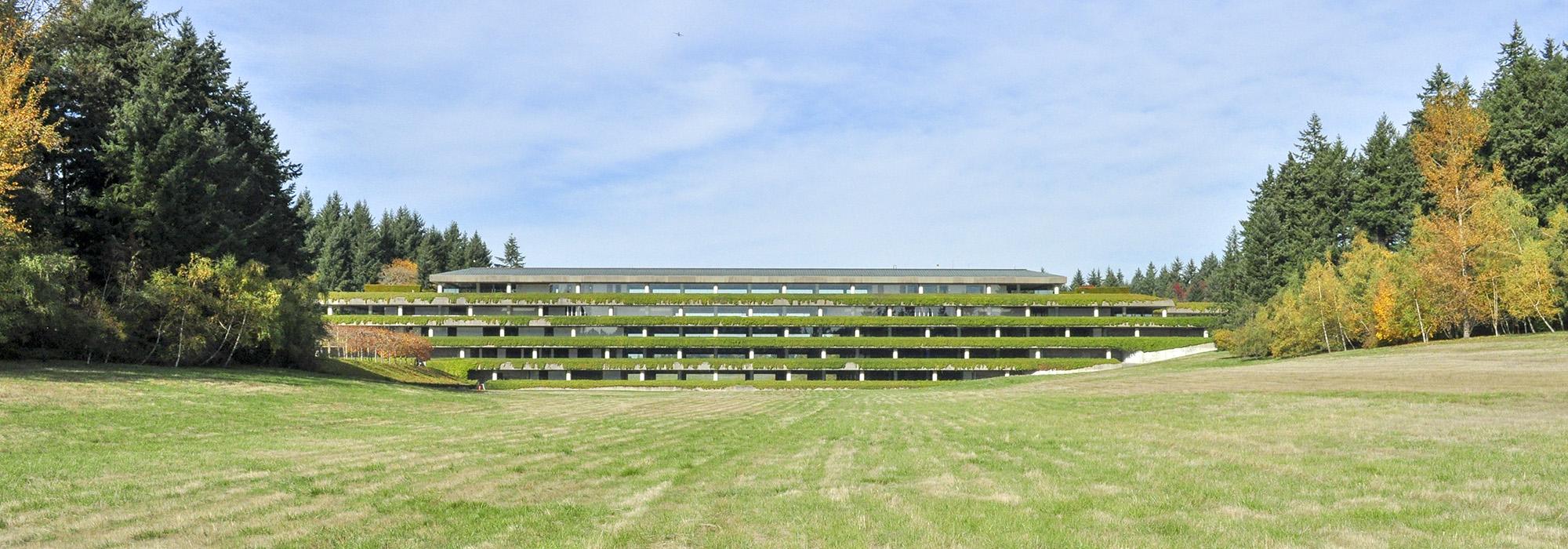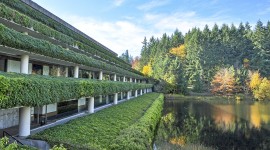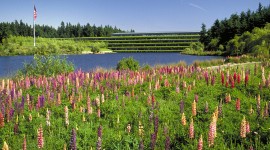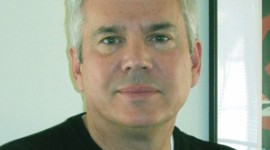David Streatfield Says Weyerhaeuser is "Unquestionably the Finest Corporate Campus in the World"
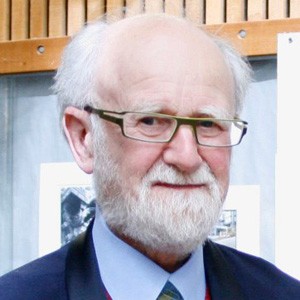
On February 1, 2021, David Streatfield, professor emeritus of Landscape Architecture and Urban Design and Planning at the University of Washington, wrote the following letter to U.S. Army Corps of Engineers Seattle district commander Col. Alexander Bullock along with one to Mayor Jim Ferrell of Federal Way, WA, concerning proposals to build 1.5-million square feet of warehouse space at the Weyerhaeuser Corporate Headquarters. The Weyerhaeuser complex, which was completed in 1972, was designed by landscape architect Peter Walker, founding principal of Sasaki, Walker & Associates, and architect Edward Charles Bassett, principal with Skidmore, Owings & Merrill. This new construction would result in the clear-cutting of some 132 mostly forested acres on the 425-acre campus.
Dear Colonel Bullock,
I write to urge you to reject the current application for the partial development of this site by the Industrial Realty Group. This proposal if fully implemented would eventually lead to a clear cut of 132 acres of this site to accommodate 5 warehouse structures covering 1.5 million square feet and approximately 45 feet tall. Two of the proposed structures would be sited adjacent to the former corporate headquarters building. I believe that executing this proposal would create an excessive impact on a site that is of unique state, national and international significance.
The former Weyerhaeuser Corporate Headquarters is a unique design that is a notable work of landscape architecture and architecture. It is also a remarkable example of enlightened corporate patronage. Peter Walker, the internationally famous landscape architect, who designed the landscape has stated that it was the most remarkable project in which he has been involved over his long and very distinguished career. At earlier notable corporate campuses such as The Bell Labs, Holmdel, New Jersey and the John Deere Headquarters at Moline, Illinois, the corporate headquarters building was carefully sited in a pastoral landscape setting framed by the landscape. In marked contrast, the design of the former Weyerhaeuser building and campus is unique. The headquarters building exists perfectly balanced within its surrounding landscape. Indeed, these qualities make it unquestionably the finest corporate campus in the world.
Since Picturesque theory first appeared in England at the end of the 18th century landscape architects and architects have explored diverse ways of establishing a visual unity between structure and landscape. For much of the 19th century architects employed variants of the Gothic style in structures to bring about a visual marriage. Weyerhaeuser is a logical conclusion to this long search. The building does not dominate its setting but appears absorbed into it. This elegant synthesis was achieved by the long low profile of the building, the very subtle manner in which plants are integrated into the structure and the absence in the glazing of the customary vertical window mullions. Continuous butt-jointed sheets of plate glass enable users of the building to enjoy completely unobstructed views of the landscape from all the interior spaces. The long planter boxes appear poised in space.
This campus project is a unique example of enlightened corporate patronage. It not only represents the seamless union of a building with the surrounding landscape but it possesses a strong public presence since it is clearly visible from two major highways. This design feature was a deliberate gesture of corporate branding by a company whose logging practices had been sometimes questioned in the past. The design symbolically declares that this corporation is a responsible environmental custodian. Not only was the campus designed to be visually accessible to the public but the extensive system of trails through the wooded areas have always been open to members of the public. Thus, it functioned as a major and rather wonderful park.
The Weyerhaeuser campus featured prominently in several lecture classes in the history of landscape architecture and environmental design that I taught over a period of 32 years at the University of Washington. It was an unusual and great pleasure to be able to tell my students that a unique masterpiece of landscape design and architecture existed just down the road that they could experience firsthand. Most of the projects we studied in my classes were either situated abroad or in other parts of this country and thus were inaccessible to many of my students. There can be no question that experiencing firsthand a masterpiece is preferable to attending a lecture in a classroom.
If implemented the proposed development of the Weyerhaeuser campus would create irreparable damage because of the excessive height and mass of the proposed structures. There is no question that the Weyerhaeuser campus can accommodate new development. This eventuality was anticipated in the recommendations for future development made in the mid-1970s master plan. The unique qualities of this design make it likely eligible for designation as a National Historic Landmark. In conducting the current Section 106 review under the National Historic Preservation Act, I urge you to adopt the master plan guidelines. Adoption of these guidelines would result in a reduction of the total amount of new warehouse space; the establishment of conservation easements on critical areas of the campus; the creation of buffer zones at least 300’ wide; and the establishment of conservation easements to ensure continued access by the public throughout the entire campus.
I urge you to ensure that this masterpiece of design of state, national and international significance is not desecrated by inappropriate new development.



